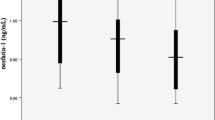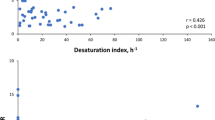Abstract
Purpose
The co-occurrence of obstructive sleep apnea (OSA) and obesity are common. Mitochondrial open reading frame of the 12S rRNA-c (MOTS-C) is one of the newly identified mitochondrial derivative peptides that play a role in the regulation of metabolic homeostasis. We aimed to examine the serum levels of MOTS-C to help understand the role of the disease in the pathophysiology, thereby investigating whether it can contribute to the appropriate treatment.
Materials and methods
Seventy patients with OSAS and 20 healthy controls were included. The serum MOTS-C level was measured in all patients. For each participant, demographic features, lipid profile, serum glucose levels, and insulin levels were also evaluated. Homeostatic model assessment indicator of insulin resistance (HOMA-IR) was calculated for all participants.
Results
Patients with OSAS (n = 70) were grouped as mild (n = 19), moderate (n = 19), and severe (n = 32). Patients with AHI ≤ 5 were considered as the healthy control group (n = 20). Mean age was 50.3 years and 74% (67/90) of the study sample was male. As expected, as the severity of OSA increased, BMI, insulin levels and HOMA-IR increased. MOTS-C levels were significantly lower in patients with OSA compared to healthy controls (p < 0.000) and we found that MOTS-C levels decreased as OSA severity increased. There was a negative correlation between serum MOTS-C levels and AHI and BMI (r = − 0.492, p < 0.001, r = − 0.382, p < 0.001, respectively). Serum MOTS-C levels were independently associated with AHI in BMI and HOMA-IR in linear regression analysis (p < 0.010, p < 0.007, p < 0.007, respectively).
Conclusion
Serum MOTS-C level is related to OSA and BMI. MOTS-C may be a useful new marker for early metabolic disorders in patients with OSA.

Similar content being viewed by others
References
The report of an American Academy of Sleep Medicine Task Force (1999) Sleep-related breathing disorders in adults: recommendations for syndrome definition and measurement techniques in clinical research. Sleep. 22:667–689
Shechter A (2017) Obstructive sleep apnea and energy balance regulation: a systematic review. Sleep Med Rev 34:59–69. https://doi.org/10.1016/j.smrv.2016.07.001
Arnaud C, Bochaton T, Pépin JL, Belaidi E (2020) Obstructive sleep apnoea and cardiovascular consequences: pathophysiological mechanisms. Arch Cardiovasc Dis 113:350–358. https://doi.org/10.1016/j.acvd.2020.01.003
Li M, Li X, Yan L (2018) Obstructive sleep apnea syndrome and metabolic diseases. Endocrinology. 159:2670–2675
Perantoni E, Filos D, Archontogeorgis K, Steiropoulos P, Chouvarda IC (2019) Pre-diabetic patients with severe obstructive sleep apnea: novel parameters of hypoxia during sleep correlate with insulin resistance. Annu Int Conf IEEE Eng Med Biol Soc 2019:5002–5005. https://doi.org/10.1109/EMBC.2019.8857457
Kanbay A, Kaya E, Buyukoglan H et al (2015) Correlation between pentraxin-3 and endothelial dysfunction in obstructive sleep apnea syndrome. Ann Thorac Med 10:199–203
Drager LF, Jun JC, Polotsky VY (2010) Metabolic consequences of intermittent hypoxia: relevance to obstructive sleep apnea. Best Pract Res Clin Endocrinol Metab 24:843–851
Singer K, Eng DS, Lumeng CN, Gebremariam A, M. Lee J (2014) The relationship between body fat mass percentiles and inflammation in children. Obesity. 22:1332–1336
Gozal D (2009) Sleep, sleep disorders and inflammation in children. Sleep Med 10:12–16
Matulewicz N, Karczewska-Kupczewska M (2016) Insulin resistance and chronic inflammation. Postepy Hig Med Dosw (Online) 70:1245–1258
Kanbay A, Ceylan E, Koseoglu İH et al (2018) Endocan: a novel predictor of endothelial dysfunction in obstructive sleep apnea syndrome. Clin Respir J 12:84–90
Morino K, Petersen KF, Shulman GI (2006) Molecular mechanisms of insulin resistance in humans and their potential links with mitochondrial dysfunction. Diabetes. 55:9–15
Zamora-Mendoza R, Rosas-Vargas H, Ramos-Cervantes MT, Garcia-Zuniga P, Perez-Lorenzana H, Mendoza-Lorenzo P, Perez-Ortiz AC, Estrada-Mena FJ, Miliar-Garcia A, Lara-Padilla E, Ceballos G, Rodriguez A, Villarreal F, Ramirez-Sanchez I (2018) Dysregulation of mitochondrial function and biogenesis modulators in adipose tissue of obese children. Int J Obes 42:618–624. https://doi.org/10.1038/ijo.2017.274
Lee C, Zeng J, Drew BG, Sallam T, Martin-Montalvo A, Wan J, Kim SJ, Mehta H, Hevener AL, de Cabo R, Cohen P (2015) The mitochondrial-derived peptide MOTS-C promotes metabolic homeostasis and reduces obesity and insulin resistance. Cell Metab 21:443–454
Zarse K, Ristow M (2015) A mitochondrially encoded hormone ameliorates obesity and insulin resistance. Cell Metab 21:355–356
Du C, Zhang C, Wu W et al (2018) Circulating MOTS- C levels are decreased in obese male children and adolescents and associated with insulin resistance. Pediatr Diabetes 19:1058–1064. https://doi.org/10.1111/pedi.12685
Qin Q, Delrio S, Wan J, Jay Widmer R, Cohen P, Lerman LO, Lerman A (2018) Downregulation of circulating MOTS-C levels in patients with coronary endothelial dysfunction. Int J Cardiol 254:23–27. https://doi.org/10.1016/j.ijcard.2017.12.001
Li H, Ren K, Jiang T, Zhao GJ (2018) MOTS-C attenuates endothelial dysfunction via suppressing the MAPK/NF-κB pathway. Int J Cardiol 268:40. https://doi.org/10.1016/j.ijcard.2018.03.031
Bonnet M, Carley D, Carskadon M et al (1992) EEG arousals: scoring rules and examples: a preliminary report from the Sleep Disorders Atlas Task Force of the American Sleep Disorders Association. Sleep 15:173–184
Johns MW (1991) A new method for measuring daytime sleepiness: the Epworth sleepiness scale. Sleep. 14:540–545
Shokolenko IN, Alexeyev MF (2015) Mitochondrial DNA: a disposable genome? Biochim Biophys Acta 1852:1805–1809
Cataldo LR, Fernández-Verdejo R, Santos JL, Galgani JE (2018) Plasma MOTS-C levels are associated with insülin sensitivity in lean but not in obese individuals. Investig Med 66:1019–1022
Ramanjaneya M, Bettahi I, Jerobin J et al (2019) Mitochondrial-derived peptides are down regulated in diabetes subjects. Front Endocrinol (Lausanne) 10:331
Xanthopoulos MS, Berkowitz R, Tapia IE (2018) Effects of obesity therapies on sleep disorders. Metabolism. 84:109–117
Bruyneel M, Kleynen P, Poppe K (2019) Prevalence of undiagnosed glucose intolerance and type 2 diabetes in patients with moderate-to-severe obstructive sleep apnea syndrome. Sleep Breath 24:1389–1395. https://doi.org/10.1007/s11325-019-01989-y
Hopps E, Caimi G (2015) Obstructive sleep apnea syndrome: links between pathophysiology and cardiovascular complications. Clin Invest Med 38:362–370
Wang J, Yu W, Gao M, Zhang F, Gu C, Yu Y, Wei Y (2015) Impact of obstructive sleep apnea syndrome on endothelial function, arterial stiffening, and serum inflammatory markers: an updated meta-analysis and metaregression of 18 studies. J Am Heart Assoc 4. https://doi.org/10.1161/JAHA.115.002454
Labarca G, Gower J, Lamperti L, Dreyse J, Jorquera J (2019) Chronic intermittent hypoxia in obstructive sleep apnea: a narrative review from pathophysiological pathways to a precision clinical approach. Sleep Breath 24:751–760. https://doi.org/10.1007/s11325-019-01967-4
Ozkok A, Ozkok S, Takır M, Yakar Hİ, Kanbay A (2018) Serum heparanase levels are associated with endothelial dysfunction in patients with obstructive sleep apnea. Clin Respir J 12:1693–1699
Qin QD, Delrio S, Wan J et al (2018) Downregulation of circulating MOTS-C levels in patients with coronary endothelial dysfunction. Int J Cardiol 254:23–27
Author information
Authors and Affiliations
Corresponding author
Ethics declarations
Conflict of interest
The authors declare that they have no conflict of interest.
Ethical approval
All procedures performed in studies involving human participants were in accordance with the ethical standards of the institutional and/or national research committee and with the 1964 Helsinki declaration and its later amendments or comparable ethical standards.
Informed consent
Informed consent was obtained from all individual participants included in the study.
Additional information
Publisher’s note
Springer Nature remains neutral with regard to jurisdictional claims in published maps and institutional affiliations.
Rights and permissions
About this article
Cite this article
Baylan, F.A., Yarar, E. Relationship between the mitochondria-derived peptide MOTS-c and insulin resistance in obstructive sleep apnea. Sleep Breath 25, 861–866 (2021). https://doi.org/10.1007/s11325-020-02273-0
Received:
Revised:
Accepted:
Published:
Issue Date:
DOI: https://doi.org/10.1007/s11325-020-02273-0




